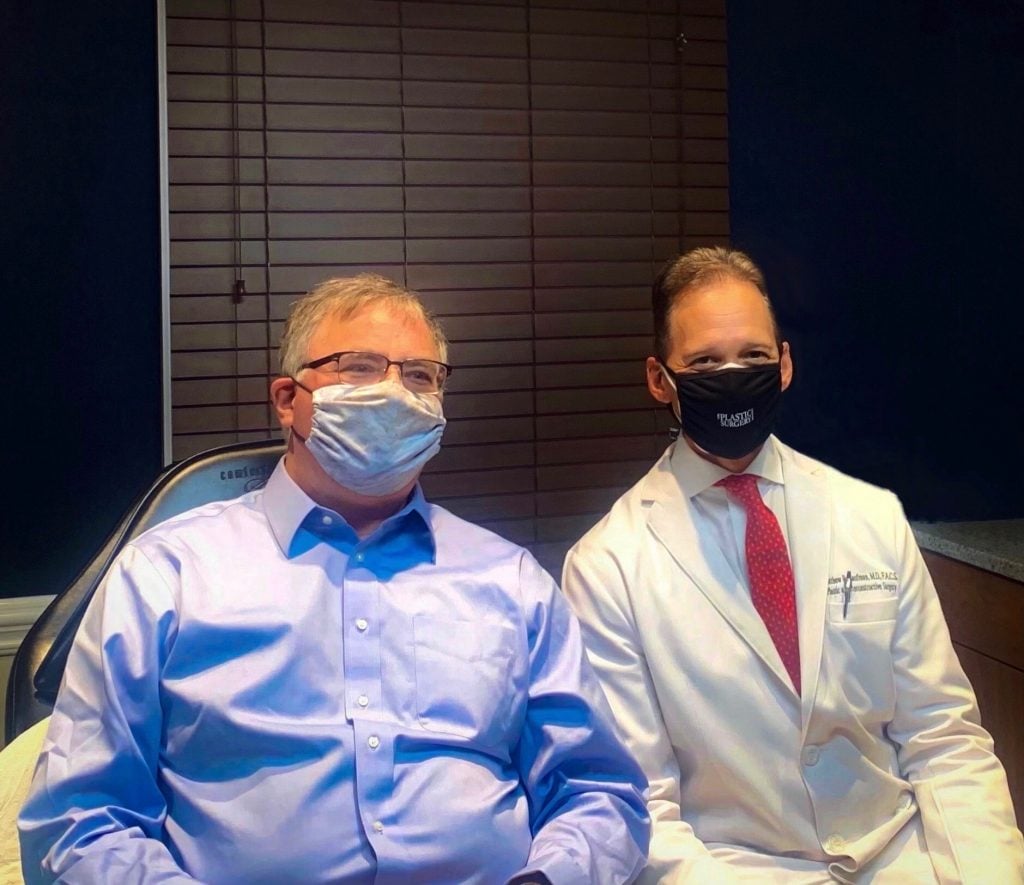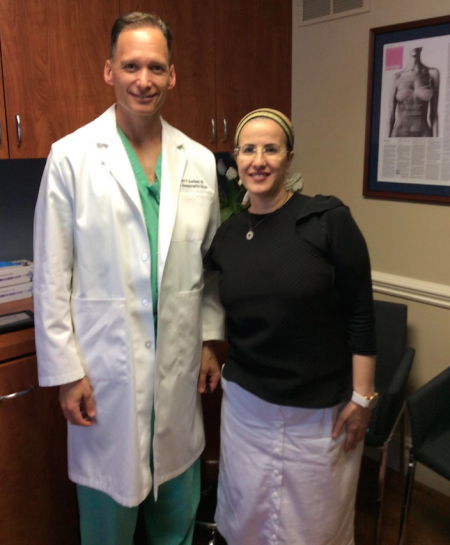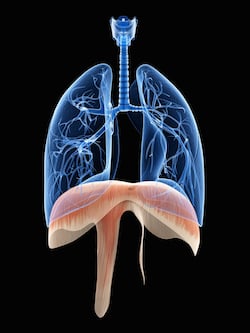Phrenic Nerve Surgery for Those Around the World
The Institute for Advanced Reconstruction (IFAR) is an internationally recognized practice with special expertise in treating phrenic nerve damage. Dr. Matthew Kaufman of IFAR, a reconstructive plastic surgeon, is board certified in both plastic and reconstructive surgery and otolaryngology (head and neck surgery). He is the only known surgeon worldwide to perform phrenic nerve reconstruction surgery to restore diaphragm muscle function, which he has done for patients across the globe. People have traveled to IFAR from countries as far as Australia, Israel, and Ireland (to name a few) and are among the 350+ patients who have benefited from this surgery.
Both national and international patients alike have reported significant improvements in physical function (e.g., regaining the ability to perform everyday tasks, exercise, etc.). In addition, many patients report a reversal of sleeping difficulties related to their diaphragm paralysis (from phrenic nerve damage). Follow-up testing has demonstrated a recovery of normal or near-normal diaphragm activity in roughly 80 percent of patients.
Defining Phrenic Nerve
The phrenic nerve controls the function of the diaphragm muscle, the primary muscle involved in breathing. Contraction of the diaphragm muscle permits expansion of the chest cavity and inhalation of air into the lungs. The signals that the phrenic nerve transmits from the brain and spinal cord to the diaphragm may be initiated voluntarily or involuntarily. (This refers to the fact that breathing can occur with conscious thought, “Okay, breathe,” or without thinking at all, such as during sleep.)
The human body has two phrenic nerves, one on the left side and one on the right side, which are mirror images of each other. Located in the neck, they pass down between the lung and heart to the diaphragm, where they receive activation signals from the brain and spinal cord.
The phrenic nerve controls both voluntary and involuntary aspects of breathing. When it is damaged, that control is reduced or lost, and normal respiratory function is compromised.
Phrenic Nerve Palsy and Paralysis
Trauma or degenerative conditions affecting the human body can result in phrenic nerve paralysis or phrenic nerve paresis, which is partial paralysis. The terms are often used interchangeably when the ultimate consequence is loss of diaphragm function.
Paralysis can be unilateral (one side) or bilateral (both sides). With unilateral paralysis, patients occasionally can be asymptomatic but more often experience breathing difficulties with exertion or exercise and sleep disturbances. This condition can sometimes be discovered incidentally, such as when patients undergo X-rays or other procedures.
Bilateral phrenic nerve damage causes diaphragm paralysis that is almost always symptomatic. The result can be moderate to severe breathing difficulty requiring oxygen therapy, CPAP or BiPAP (positive pressure oxygen support), and even sometimes a need for mechanical ventilation. The significant loss of lung function makes the patient extremely susceptible to recurrent bouts of pneumonia.
There are various tests used to diagnose diaphragm paralysis, an indication of phrenic nerve damage. These include:
- Pulmonary function test
- Diaphragm fluoroscopy (also called a “Sniff Test”)
- Nerve conduction studies (NCS) and EMG (electromyography) of phrenic nerve and diaphragm
- Chest X-ray
- Blood test (to measure oxygen in the blood and to rule out neurological disorders)
- CT of the thorax and/or abdomen
- MRI of the cervical spine
- Ultrasound of the diaphragm to detect lack of or abnormal movement
Causes of Phrenic Nerve Damage
Although up to 50 percent of cases may be idiopathic (unknown origin), damage to the phrenic nerve can occur from a number of general causes, including:
- Surgical injury (the nerve is accidentally harmed while being operated on in the neck or chest for other causes. This is especially true for cardiac surgery, which has been associated with a 10 percent incidence of phrenic nerve injury)
- Anesthetic injury (inadvertent damage during an interscalene nerve block for shoulder surgery)
- Manipulation injury (e.g., chiropractic)
- Trauma (e.g., a fall or car accident)
- Spinal cord disorders or quadriplegia
- Chronic “wear and tear” in the neck from repeated “mini-traumas” (for example, years of playing contact sports or doing manual labor)
Other causes include certain types of cancer (lung, throat, neck), ALS, multiple sclerosis, muscular dystrophy, and neuropathic disease, including thyroid and autoimmune disease.
Symptoms of Phrenic Nerve Damage
The primary symptom of phrenic nerve damage and the resulting diaphragm paralysis is breathing difficulty (known as dyspnea). This can occur with exertion (especially swimming in water up to the chest) or in a lie-flat position. However, when severe enough, it can occur under all circumstances.
Those suffering from this condition may also experience poor sleep (insomnia), anxiety, fatigue, and morning headaches. Some patients can suffer from GI symptoms, such as nausea or heartburn.
Surgical Options
Phrenic Nerve Reconstruction Surgery
Advances in peripheral nerve microsurgery have enabled Dr. Kaufman to reverse diaphragm paralysis by applying these surgical methods. The techniques he utilizes are derived from the procedures commonly used to treat arm or leg paralysis, which allows surgeons to restore function to previously paralyzed muscle groups.
Phrenic nerve reconstruction surgery consists of releasing scar tissue compressing the phrenic nerve in conjunction with nerve transfers from adjacent (donor) nerves and/or a sural nerve graft to bypass the damaged section of the nerve.
Phrenic nerve surgery is further detailed in a chapter authored by Dr. Kaufman in a comprehensive book. The book Rehabilitative Surgery: A Comprehensive Text for an Emerging Field is also edited by Dr. Kaufman and his colleagues at IFAR.
Breathing Pacemakers
In a related procedure, advances have also enabled Dr. Kaufman to assist scores of other patients by providing them with a breathing pacemaker. This can provide ventilator support for patients with certain conditions, such as high spinal cord injury or ALS (also known as Lou Gehrig’s disease), when the diaphragm no longer functions independently. Dr. Kaufman has successfully treated some of the most complicated cases of ventilator-dependent spinal cord injury and bilateral diaphragm paralysis through simultaneous implantation of diaphragm pacemakers and phrenic nerve reconstruction.
A breathing pacemaker controls activity in the diaphragm. Electrodes are implanted around the nerves to the diaphragm (phrenic nerves) or placed directly into the muscle, causing an inspiratory (inhalation) event to occur.
IFAR is the only practice worldwide that implants diaphragm pacemakers in select patients with severe unilateral diaphragm paralysis simultaneous with phrenic nerve reconstruction in order to assist in successfully restoring breathing muscle activity.
Diaphragm Muscle Replacement Surgery
This is a relatively new procedure in which healthy muscle from the patient’s body is transferred into the chest cavity, replacing the irreversibly damaged diaphragm and restoring functional breathing activity. Although this procedure has been previously described in children with congenital diaphragm problems, Dr. Kaufman and his team are the first in the world to offer it selectively to both children and adults who have diaphragm paralysis.
Post-Surgery Recovery
Recovery from phrenic nerve surgery entails nerve regeneration, which is usually achieved in 12 to 18 months after surgery. Patients are likely to have optimal results when completing diaphragm rehabilitation therapy, which begins four to six weeks post-operatively. During the first 12 months following surgery, a clinical support staff person will follow up with a patient to complete an assessment to measure progress. Repeat diagnostic testing is done one year after surgery.
A Personalized Consultation
IFAR has patient care coordinators available to arrange a medical record review with our phrenic nerve team and coordinate a phone or virtual consult with the physician to determine whether his/her patient may be a candidate for surgery.
In order to best provide our services, a paralyzed diaphragm should already be diagnosed. In addition, our experts will ask a candidate to provide the following information:
- When (month/year) was the candidate diagnosed with a paralyzed diaphragm?
- What side(s) of the diaphragm is paralyzed?
- Did he/she have surgery or trauma that caused damage to the phrenic nerve?
- Does the candidate experience numbness and/or tingling in the upper extremities?
- When was the most recent Sniff Test (chest fluoroscopy) completed?
- When was the most recent pulmonary function test completed?
- Has the candidate had an EMG nerve study completed for the phrenic nerve and diaphragm?
IFAR is fully equipped to provide care to international patients. This includes everything from coordination of medical records to concierge services, such as travel arrangements, hotels, language translation, and religious services. For more information on phrenic nerve reconstruction, breathing pacemakers, and traveling to our office, please request an appointment.






